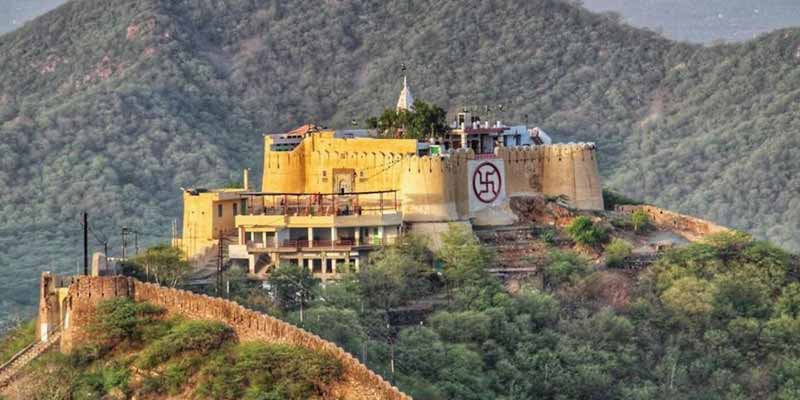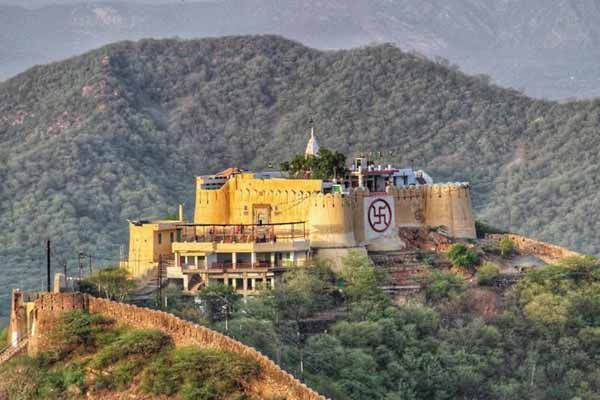Garh Ganesh Temple Jaipur is a revered Hindu temple located within the Nahargarh Fort in Jaipur, Rajasthan. Dedicated to Lord Ganesha, the temple holds historical and religious significance in the city. Believed to have been constructed by Maharaja Sawai Jai Singh II, the founder of Jaipur, in the 18th century, the temple is a testimony to the city’s rich cultural heritage. It is said that Maharaja Jai Singh sought the blessings of Lord Ganesha before commencing the construction of Jaipur. The temple has since become an important place of worship and a symbol of faith for the locals.
Situated on the Aravalli Hills, the Garh Ganesh Temple offers a breathtaking view of the surrounding landscape. Visitors can climb up to the temple through the Nahargarh Fort, enjoying panoramic vistas along the way. The serene atmosphere and tranquil surroundings make it an ideal spot for spiritual contemplation and introspection. The temple’s architecture showcases the traditional Rajasthani style. Intricate carvings, ornate designs, and beautifully adorned pillars add to its aesthetic appeal. Inside the sanctum sanctorum, there is an ancient idol of Lord Ganesha, believed to be one of the oldest in Jaipur. Devotees flock to the temple to offer prayers, seek blessings, and participate in religious ceremonies.

The Garh Ganesh Temple Jaipur holds special significance during the festival of Ganesh Chaturthi. Celebrated with great fervor, this festival marks the birth of Lord Ganesha. The temple premises come alive with decorations and devotional music, attracting a large number of devotees who engage in prayers and rituals. Besides its religious importance, the Garh Ganesh Temple is also popular among nature enthusiasts and trekkers. The route to the temple involves a short trek through the picturesque Aravalli Hills, offering an opportunity to connect with nature and enjoy the scenic beauty of the surroundings.
In summary, the Garh Ganesh Temple in Jaipur is a historical and sacred place of worship dedicated to Lord Ganesha. Its association with Maharaja Jai Singh II, stunning location, and architectural beauty make it a significant attraction in the city. Whether for religious purposes, sightseeing, or trekking adventures, a visit to the Garh Ganesh Temple provides a memorable and enriching experience Rajasthan Budget Tours.
History of Garh Ganesh Temple
The Garh Ganesh Temple Jaipur has an intriguing history that is closely associated with the city’s founding and the devotion of its founder, Maharaja Sawai Jai Singh II. The temple holds a special place in the hearts of Jaipur’s residents and visitors.
According to popular belief, Maharaja Jai Singh II began the construction of Jaipur in the early 18th century. However, he faced challenges and obstacles in the process. Seeking divine intervention and blessings for the successful completion of his ambitious project, the Maharaja decided to seek the blessings of Lord Ganesha, the remover of obstacles and the god of wisdom and prosperity Rajasthan Monuments.
It is said that Maharaja Jai Singh II visited the Garh Ganesh Temple Jaipur, situated within the premises of Nahargarh Fort, before commencing the construction of Jaipur. He offered prayers and sought the blessings of Lord Ganesha for the smooth execution of his plans. This act of devotion is believed to have played a significant role in the success and prosperity of Jaipur.
The Garh Ganesh Temple itself is believed to have been built by Maharaja Jai Singh II as a tribute to Lord Ganesha. The temple’s architecture reflects the traditional Rajasthani style, with intricate carvings, ornate designs, and beautiful craftsmanship. Inside the temple, an ancient idol of Lord Ganesha is worshipped, which is considered one of the oldest idols in Jaipur.
Over the years, the Garh Ganesh Temple has remained an important religious site for the people of Jaipur. It has witnessed countless prayers, rituals, and festivals, attracting devotees from far and wide. Ganesh Chaturthi, the festival celebrating Lord Ganesha’s birth, is particularly significant at this temple. During this time, the temple premises are adorned with decorations, and devotees throng to offer prayers and seek the blessings of Lord Ganesha.
The historical and cultural significance of the Garh Ganesh Temple Jaipur cannot be overstated. It not only serves as a place of worship but also stands as a symbol of the city’s foundation and the devotion of its founder. The temple’s association with Maharaja Jai Singh II and its role in the construction of Jaipur have contributed to its enduring popularity and reverence among the people of Jaipur and visitors alike.
How to Reach Garh Ganesh Temple
To reach the Garh Ganesh Temple Jaipur, you can follow these directions:
By Road: Jaipur is well-connected by road networks, and reaching the Garh Ganesh Temple by road is convenient. You can hire a taxi or take a local bus from any part of Jaipur to Nahargarh Fort, where the temple is located. The temple is approximately 6 kilometers away from the city center, and the journey takes around 20-30 minutes, depending on the traffic.
By Air: If you are arriving by air, the nearest airport is Jaipur International Airport, which is well-connected to major cities in India and some international destinations. From the airport, you can hire a taxi or take a pre-paid cab to reach the Garh Ganesh Temple. The temple is around 17 kilometers away from the airport, and the travel time is approximately 45 minutes to 1 hour, depending on the traffic.
By Train: Jaipur is well-connected to major cities in India by rail. If you are arriving by train, you can take an auto-rickshaw, taxi, or local bus from the Jaipur Railway Station to reach the Garh Ganesh Temple. The distance between the railway station and the temple is around 11 kilometers, and it takes approximately 30-40 minutes to reach, depending on the traffic.
Once you reach Nahargarh Fort, you can enter the fort premises and follow the pathway that leads to the Garh Garh Ganesh Temple Jaipur. The temple is located within the fort complex, and it involves a short walk or climb to reach the temple area.
It’s advisable to check the opening hours of the temple before planning your visit and to carry some drinking water and comfortable footwear for the short trek to the temple.
